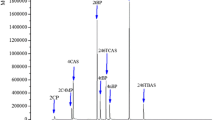Abstract
Solid-phase microextraction (SPME) represents a very simple and rapid method for the extraction of organophosphorus, triazine and 2,6-dinitroaniline pesticides from aqueous samples without making use of any solvents. The same fiber can be used repeatedly. Moreover, a sample volume as small as 3 mL can be employed with no loss in sensitivity. 34 compounds have been extracted from aqueous samples by SPME using a 85 μm polyacrylate fiber. For organophosphorus pesticides, a 100 μm polydimethylsiloxane fiber has been used additionally for comparison. The fibers were directly introduced into the heated split/splitless injector of the gas chromatograph and determined using a nitrogen-phosphorus detector. The method was evaluated with respect to the limit of detection (LOD), linearity and precision. The limit of detection (LOD) depends on the compound and varies from 0.005–0.09 μg/L. The method is linear over at least three orders of magnitude with coefficients of correlation usually >0.999. For triazines and 2,6-dinitroanilines the coefficient of variation (precision) is <8% while for organophosphorus compounds it may reach values up to 18% (however, if the latter compounds are extracted using the polydimethylsiloxane phase considerably higher precision is achieved). The partitioning of the analyte between the aqueous phase and the polymeric phase depends on the hydrophobicity of the compound as expressed by the octanol/water partitioning coefficient (Pow). For triazines it was shown that there is a linear dependence of the logarithm of the analyte response on the log(Pow) i.e. the higher the hydrophobicity, the higher the affinity of the analytes to the polymeric phase of the fiber and the higher the response. Salt addition has a strong effect on the extraction efficiency. This effect increases with decreasing hydrophobicity (increasing polarity) of the compound. The triazines ametryn, atrazine, propazine, simazine and simetryn have been identified in a ground water well sample by SPMEGC/NPD.
Similar content being viewed by others
References
U.S. Environmental Protection Agency, National Survey of Pesticides in Drinking Water Wells, Phase I Report: 1990; Office of Water and Office of Pesticides Programs. U.S. Government Printing Office: Washington, DC, 1990; EPA-570/9-90-015
EEC Drinking Water Guideline, 80/779/EEC, EEC No. L229/11-29, EEC, Brussels, August 30, 1980
Eisert R, Levsen K, Wünsch G (1995) J Environ Anal Chem (in press)
Junk GA, Richard JJ (1988) Anal Chem 60:451–454
Loconto PR, Gaind AK (1989) J Chromatogr Sci 27:569–573
Bolygó E, Atreya NC (1991) Fresenius J Anal Chem 339:423–430
Lartiges S, Garrigues P (1993) Analusis 21:157–165
Mattern G, Louis JB, Rosen JD (1991) J Assoc Off Anal Chem 74 (9):982–986
Arthur CL, Pawliszyn J (1990) Anal Chem 62:2145–2148
Arthur CL, Killam LM, Buchholz KD, Pawliszyn J, Berg JR (1992) Anal Chem 64:1960–1966
Arthur CL, Killam LM, Motlagh S, Lim M, Potter DW, Pawliszyn J (1992) Environ Sci Technol 26:979–983
Louch D, Motlagh S, Pawliszyn J (1992) Anal Chem 64:1187–1199
Chai M, Arthur CL, Pawliszyn J, Belardi RP, Pratt KF (1993) Analyst 188:1501–1505
Zhang Z, Pawliszyn J (1993) J High Resolut Chromatogr 16:689–692
Potter DW, Pawliszyn J (1994) Environ Sci Technol 28:298–305
Buchholz KD, Pawliszyn J (1993) Environ Sci Technol 27:2844–2848
Buchholz KD, Pawliszyn J (1994) Anal Chem 66:160–167
Zhang Z, Pawliszyn J (1993) Anal Chem 65:1843–1852
Arthur CL, Potter DW, Buchholz KD, Motlagh S, Pawliszyn J (1992) LC-GC 10 (9):656–661
Arthur CL, Chai M, Pawliszyn J (1993) J Microcol Sep 5:51–56
Hawthorne SB, Miller DJ, Pawliszyn J, Arthur CL (1992) J Chromatogr 603:185–191
Potter DW, Pawliszyn J (1992) J Chromatogr 625:247–255
Page BD, Lacroix G (1993) J Chromatogr 648:199–211
Arthur CL, Pratt K, Motlagh S, Pawliszyn J, Belardi RP (1992) J High Resolut Chromatogr 15:741–744
Motlagh S, Pawliszyn J (1993) Anal Chim Acta 284:265–273
Berg JR (1993) Am Lab (Shelton, Conn.) 25 (17):18–24
Eisert R, Levsen K, Wünsch G (1994) J Chromatogr A 683:175–183
Noble A (1993) J Chromatogr 642:3–14
Author information
Authors and Affiliations
Rights and permissions
About this article
Cite this article
Eisert, R., Levsen, K. Determination of organophosphorus, triazine and 2,6-dinitroaniline pesticides in aqueous samples via solid-phase microextraction (SPME) and gas chromatography with nitrogen-phosphorus detection. Fresenius J Anal Chem 351, 555–562 (1995). https://doi.org/10.1007/BF00322732
Received:
Accepted:
Issue Date:
DOI: https://doi.org/10.1007/BF00322732




